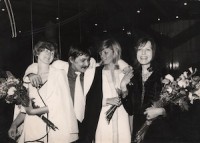
40 Years Ago: RWF’s THE BITTER TEARS OF PETRA VON KANT
 A chamber play about dependency and the economics of emotions
A chamber play about dependency and the economics of emotions
On June 25, 1972, Fassbinder’s thirteenth feature film, THE BITTER TEARS OF PETRA VON KANT, premiered as a German competition entry at the Berlin Film Festival and earned him a nomination for the festival’s top award, the Golden Bear.
The genesis of the film, as so often the case with Fassbinder’s work, lay in a stage play. Speaking at the recent opening of the Fassbinder exhibition in the German Theater Museum in Munich (May 25 – September 9), Margit Carstensen, who plays the main role in the film, described the play’s initial teething problems when it was first directed by Peer Raben at the Landestheater Darmstadt on June 5, 1971 as part of the Frankfurt festival “experimenta 4.” Today the play is one of RWF’s most frequently performed works for stage and has had over 200 premieres around the world. When translating the script into film, there was no attempt to disguise its theatrical origins. The film is divided into five clearly recognizable acts and the entire action takes place in a single room. The beginning of the film features the insert: “A case history – dedicated to the one who became Marlene here.”
The film focuses on a theme that has a fundamental significance in Fassbinder’s world: Is love an alternative to the predominant lack of freedom or is it rather a reproduction of this lack of freedom? (See Christian Braad Thomsen’s Fassbinder: The Life and Work of a provocative Genius.) As Fassbinder himself stated, “My view of love relationships in their classic form is that relationships involving two people represent repressive strategies of the existing society.” In THE BITTER TEARS OF PETRA VON KANT, he explores this perspective in exemplary fashion in the context of a purely female constellation. The successful fashion designer Petra von Kant has settled into a lonely life between the catwalk and conspicuous consumption. Separated from her husband, she now lives with her slavishly devoted maid Marlene. One day Petra meets the beautiful young Karin, who exploit’s Petra’s love in order to gain a foothold in the glossy world of professional modeling.
THE BITTER TEARS OF PETRA VON KANT was shot in January 1972 over only ten days as a studio production for Tango Film on 35 mm color film in an artists’ colony in Worpswede in Lower Saxony, northeast of Bremen. The production budget was 325,000 deutschmarks.
The German film rating organisation, Filmbewertungsstelle (FBW), awarded the film its coveted “especially valuable” certification. THE BITTER TEARS OF PETRA VON KANT began its official run in German cinemas on October 5, 1972. At the German Film Awards in 1973, leading actor Margit Carstensen and cinematographer Michael Ballhaus were each presented with a “film strip in gold,” the event’s highest award, for their work on the film.
More information:
RWFF filmography on THE BITTER TEARS OF PETRA VON KANT
Photo right: Irm Herman, RWF, Katrin Schaake, Margit Carstensen at the Berlin Film Festival in 1972, © Erika Rabau / RWFF archive